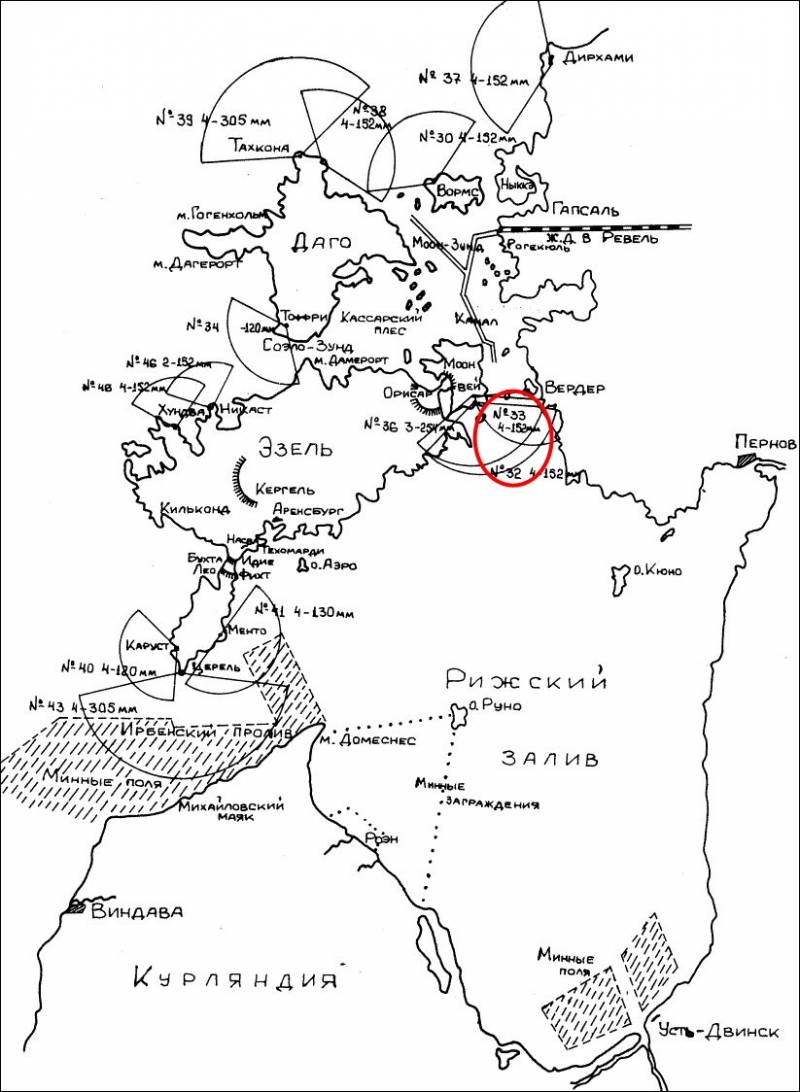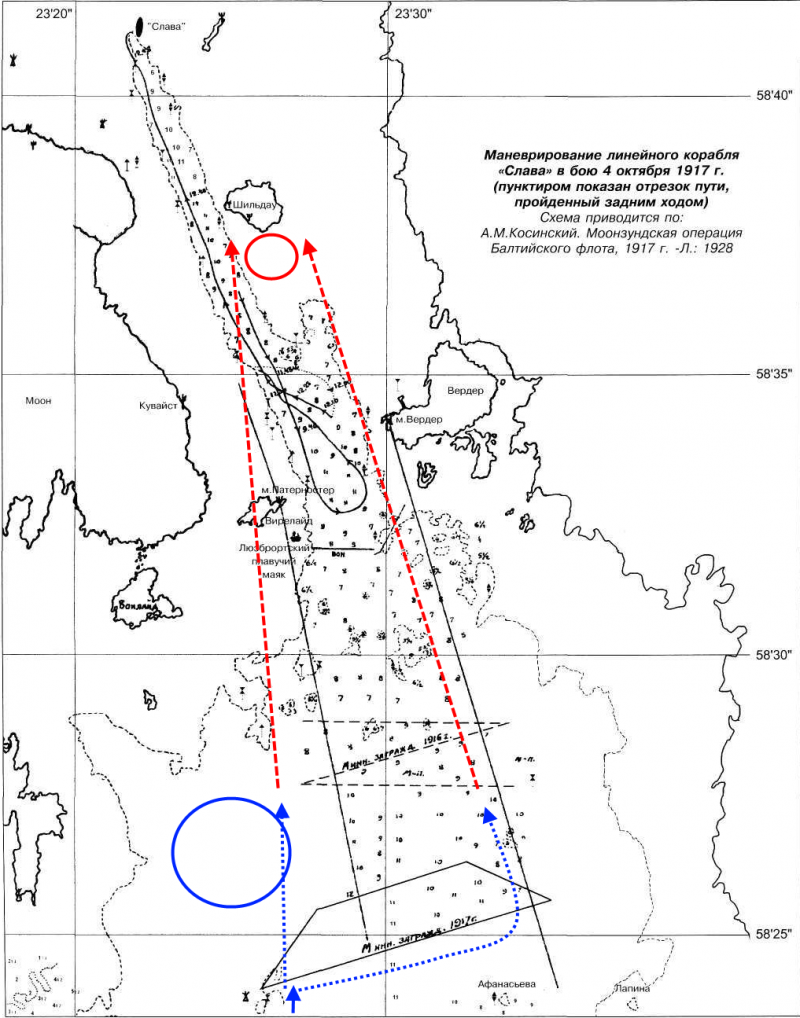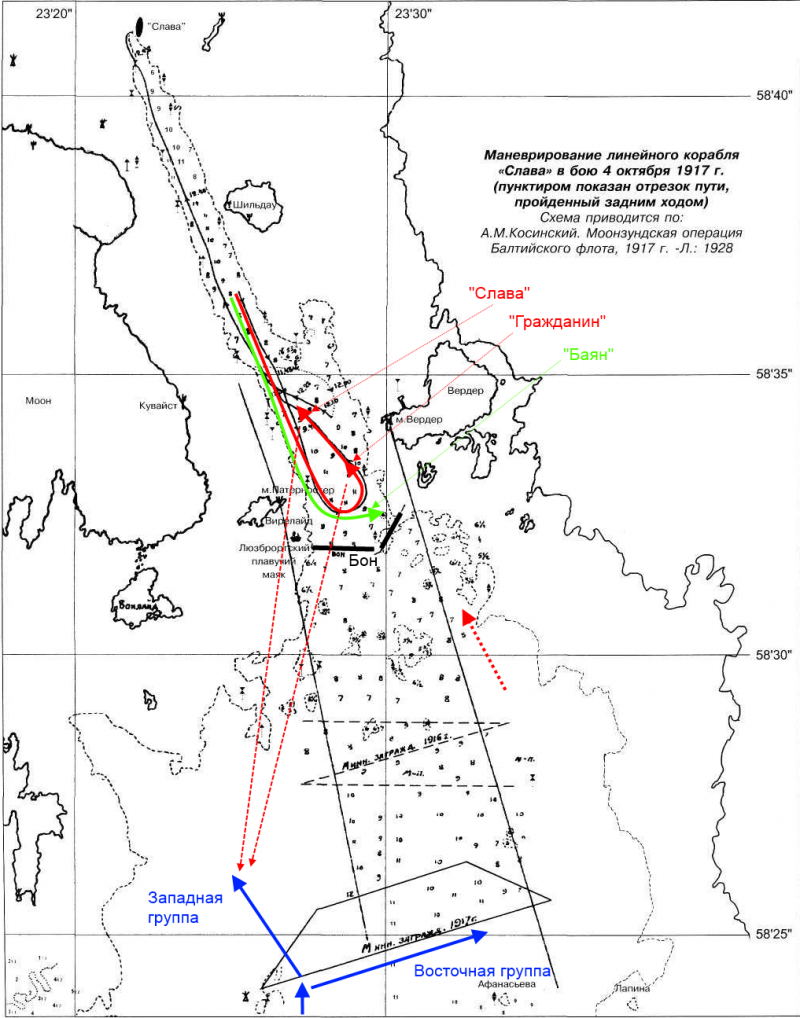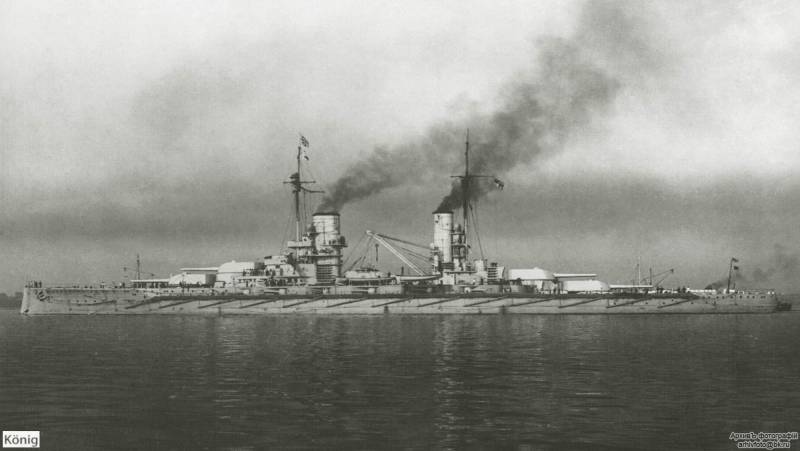Four battles of "Glory", or Efficiency of mine-artillery positions (part 4)
In order not to force readers to search for the previous article, we will present the map of the Moonsund Archipelago once again, highlighting on it the place of the 4 battle of October
Further. Let's just say, almost all the descriptions of the October 4 bout are either extremely compressed and do not allow to understand how Russian and German ships maneuvered and fired, or they are replete with terrain references (“having reached Paternoster Parallel, went to the island”), which without a map and the directory can not figure out what the reader usually does not. Therefore, the author took the liberty to portray the movement of ships, putting them on the scheme from the book Kosinsky. Of course, these schemes are conditional and do not correspond to the exact maneuvering of ships, but still give a rough idea of what is happening.
Let us consider the place where the battle took place. As we have said, the Russian ships during the 4 battle of October maneuvered in the Bolshoi Zund strait, which separates the island of Muon from the island of Werder and the mainland. This strait was defended by two minefields: one set in 1916 directly at the entrance to the Bolshoi Zund from the Gulf of Riga, and the second set in 1917 a little to the south of the first.
But there was also a third. The fact is that the Germans, wanting to block the exit to the Gulf of Riga, put a few mine cans from an underwater minelayer (their approximate location is highlighted in blue in the diagram; unfortunately, the author does not have an exact map of the barrier). In essence, they only hurt themselves: the Russians strayed the fairway in this barrier and calmly used it, while the Germans, in fact, only strengthened the mine position of the Russians at the Great Zund. But then the Germans had an idea about the location of the Russian minefields.
The German commander (Vice-Admiral Behnke) led his ships from the south (blue solid arrow) and did not have the slightest desire to storm the 1917 barrage of the year head-on. He intended to bypass it from the west or east (blue dotted line) and bring its battleships to the southern edge of the 1916 minefield. From there, König and Kronprinz could fire Russian ships right up to Schildau Island (the trajectory is red dotted line). By the way, just near this island the battleships “Glory” and “Citizen” (red circle) settled down for the night.
The choice between the western and eastern aisle was very difficult. In the west, as mentioned above, there was a German minefield, which should now be forced. In the east, there was less mine danger, but the movement of ships made it difficult for shallow water areas — the banks of Afanasyev and Larin. As a result, the German vice-admiral did not choose, but decided to trawle up both aisles, and then how it will turn out.
Interestingly, the Russian naval destroyers "Active" and "Deliverable" found the enemy before dawn. The ships Benke dismantled at dawn and in 08.10 began to move towards the Russian minefields, but even before 08.00, that is, before the Germans went ahead, the commander of the naval forces of the Gulf of Riga (MSRZ) M.K. Bakhirev received a message from “Active”: “I see 28 fumes on SW” and soon after that: “The enemy forces are going to Kuivast”.
In response, M.K. Bakhirev ordered the "Active" to continue monitoring and find out which ships are part of the German squadron, and immediately ordered the "Citizen" and "Glory" to go to the Kuivast raid. Around 09.00, the battleships came, and on the "Glory" they were in such a hurry to fulfill the order of the vice-admiral that they did not choose anchors, but riveted anchor chains. At the same time, M.K. Bakhirev gave the command to the other ships (barriers, destroyers, transports), standing on the Kuivast roadstead, to go north. This was absolutely the right decision, because there was no point in exposing them to the blow of the German dreadnoughts.
The question arises: why M.K. Bakhirev did not attempt to use the armored cruiser “Admiral Makarov”, the armored cruiser “Diana” and the newest destroyers “noviki” in the battle against the squadron breaking through from the south? The answer lies in the fact that on the day of 4 October, the naval forces of the Gulf of Riga were, in fact, two separate battles: from the very morning the enemy became more active in the Kassar Reach. "Diana" was sent to the Moonsund Strait, "Admiral Makarov", taking the water into their compartments and, in the image and likeness of "Glory" in 1915, created a list in 5 degrees, had to support the destroyers with fire. In no case could it be possible to ignore the enemy forces in the Kassar Reach: this not only put the land defenders of the island of Muon in danger, but also provided a theoretical opportunity for the Germans to cut off the retreat path of the Russian ships, at least sketching mines in the Strait of Moonsund.
Almost simultaneously with the approach of the Russian battleships to Kuivast, the German squadron of Vice-Admiral Behnke "stumbled" into the south-western edge of the Russian 1917 minefield in
In other words, everything was ready for battle for 09.00: both the Germans and the Russians concentrated their forces. The Germans began trawling the 1917 barrage, the Russians concentrated a detachment of ships, which they gathered to confront the Germans as part of Glory, Grazhdanin, and the armored cruiser Bayan under the flag of the MRPD commander and the destroyers covering them.
Visibility was excellent; in general, 4 October Day 1917 g was characterized as “beautiful, clear”.
Period 09.00-10.05
Having entered the minefield, the Germans immediately proceeded to the trawling, their other ships stopped. In the interim, 09.15-09.23 “König” fired on the patrol destroyers “Active” and “Efficient” (direction of movement - red dotted arrow), using 14 projectiles from the 86-97 cable, but did not achieve hits. For nearly an hour, Beckers minesweepers worked implacably, and then, in 09.55, the German squadron split into two parts. Six minesweepers and nine minesweeper boats under the cover of the light cruisers “Kolberg” and “Strasbourg” (in the diagram - the western group) went through the Russian and German minefields to the Malaya Zund to support the ground forces' breakthrough to Mawn. At the same time, the main forces (eastern group), including both dreadnought of the Germans, went along the minefield to the east in order to try to pave the way around the barrier from the east.
In Russian, everything was much "more fun." Approximately in 09.12, the enemy was seen and identified (most likely from “Active” and “Deliverable”, since at that time only they could see the enemy well). In his "Report" M.K. Bakhirev indicated such a composition of forces:
As we know, the German forces consisted of only two dreadnoughts and two light cruisers, but when identifying a group of ships from a long distance, such errors are more than excusable, especially since the main enemy (dreadnoughts) were identified correctly.
On the "Citizen", "Glory" and "Bayan" they declared a battle alarm and raised flag flags. But at that moment the Germans launched the bombardment of the artillery batteries of Mon. This is how M.K. Bakhirev:
Here you should pay attention to the time difference between German and domestic sources. In continuation of the quoted passage by M.K. Bakhirev writes:
It turns out that the Germans opened fire after 09.30. While according to German data, shelling was carried out in 09.12-09.23. In general, one can only say for sure that at first our ships detected the enemy and prepared for battle, and then German seaplanes appeared. Despite the presence of anti-aircraft guns on our ships, the seaplanes didn’t fire, because these guns didn’t have their own calculations, they were manned from other ship guns and it was decided not to distract them.
Further M.K. Bakhirev ordered the nomination for a combat position. And what happened next causes admiration, shame and laughter at the same time. S.N. Timirev, the commander of the Bayan cruiser, describes the incident as follows:
What is a könig dreadnought?
This is a sea fortress, armed with ten magnificent 305-mm Krupp cannons, with which our latest 305-mm Tserel battery cannons could have fought. Developed back in the 19 century, the 305-mm cannon "Citizen" and "Glory" were much weaker. At the same time, “Koenig” is perfectly protected: it is capable of destroying any armadillos of the world, while remaining lowly vulnerable to their projectiles. Perhaps four battleships in their combat power and could equal one dreadnought of this type. Perhaps four Bayan-type cruisers had any chance of success, having fought with one battleship. But what should the officers of “Bayan” feel when they went to meet two dreadnoughts like “König”? Recall that the British admiral Trubridge, having four armored cruisers, each of which was larger and stronger than the Bayan, did not dare to block the road to a single Geben single battle cruiser, and the Goben was weaker than the Koenig.
And it would be okay if the risk was only in danger of being substituted for the Germans 305-mm guns. But neither S.N. Timirev, no M.K. Bakhirev could not be sure of the crew of his cruiser: what could the "activists" of the shipboard committee make of it when the risk of the planned enterprise became clear to them? Nevertheless, the officers remained in their places and did their duty.
The movement of “Bayan”, obviously, shamed the team “Glory” and “Citizen” and they seemed to have gone to the position. Why "like"? Let's remember what S.N. Timirev:
That is, after taking the position, the battleships were supposed to be between the "Bayan" and the German ships. And what happened in practice?
"Bayan" went to the position, which was supposed to be at the boom (highlighted in the diagram bold), but without reaching it, turned to the left (green arrow) and missed the battleships ahead. It was assumed that "Glory" and "Citizen" will take the fight, turning astern to the enemy. The fact is that it was practically impossible to maneuver on the “open spaces” of the Big Zund, and if the ship, being under enemy fire or damaged, would start a turn, he would risk being in the shallows. Therefore, it was better to immediately turn around so that, if necessary, there was a possibility of retreat. At the same time, "Glory" was to be located further, and "Citizen", due to the fact that his tools were less long-range - closer to the enemy.
Armadillos and turned around. But so, that after their turn (red arrow), instead of standing in front of the “Bayan” at the booms, they were far to the north, which is why the flagship M.K. Bakhireva was the closest ship to the Germans!
Interestingly, this moment is absolutely not advertised anywhere. M.K. Bakhirev noted only:
Mikhail Koronatovich did not begin to dramatize the actions of his ships. Suffice it to say that he did not mention the delay of the “Citizen” and “Glory” and their unwillingness to go to the position at all.
In 09.50, the Mone Island battery fired at the minesweepers who bypassed the 1917 minefield from the west, but quickly fell silent, most likely due to undershoes, because the distance to the enemy was still too far. Approximately to 10.00, the ships took up positions, and the battleships began to turn, leading the enemy to the course angle 135 degrees on the port side. The 10.05 fired the Citizen, but its projectiles lay down in great gaps, and the fire was stopped. Half a minute later, “Glory” entered the battle, firing at the minesweepers of the western group (red arrows on the diagram).
Period 10.05-11.10
So, the Russian battleships struck the minesweepers, rushing towards the Small Sound, but only Glory “reached” them. The distance was 112,5 cable. Interestingly, the Slava was armed with the very “9-foot” range finders, the low quality of which, according to some researchers, sharply reduced the accuracy of the British battle cruisers in the Jutland battle. But on Slava, they showed themselves very well: the first volley of the battleship gave a flight, the second - a shortage, and the third - a covering, after which the German minesweepers put a smoke screen.
The light cruisers of the group, bursting from the west, of course, could not compete with the guns of the Russian battleship, so the dreadnoughts of Benke tried to support their fire. In 10.15, Koenig fired at the Bayan cruiser, and the Kronprinz fired five five-armored volleys at the Citizen. But the distance to the “Citizen” was too great, and the “Kronprinz” stopped shooting, and the “Bayan”, apparently within the reach of the “Koenig” (the first volley went very close to the stern of the cruiser), moved away to the east and also turned out to be beyond the range of German heavy guns.
Up to this point, the description of the battle does not contain anything contradictory, but further certain difficulties begin. It is very likely that this was the case.
The minesweepers of the detachment that came under fire went in two groups. Ahead of 8-th semi-flotilla, behind - 3-y division. Most likely, "Glory" fired at the head of the 8 th semi-flotilla and forced her to hide behind a smoke screen, during which time the 3 Division approached closer and fired at "Citizen", as a result of which these minesweepers also had to retreat . Both Kosinsky and Vinogradov claim that at the same time the “Citizen” tried to fire at the eastern group of minesweepers from 152-mm guns, but it should be noted that these minesweepers were too far away to be able to shoot from such guns. Maybe they just gave a couple of volleys for the excitement? Unfortunately, the author is unknown.
The Russian battleships fought, remaining motionless, although they did not anchor: they were kept in one place, working as machines. In 10.30 M.K. Bakhirev ordered to fire "at the nearest enemy."
Around 10.50, the smoke screen set by the western group was finally dispelled. It turned out that the retreating minesweepers had previously regrouped and started the trawling again, and now they were much closer than before. Glory opened fire on them with 98,25 KBT. She was immediately supported by the "Citizen" and "Bayan", as well as the battery of Món. It was at that moment, according to Russian observers, that one enemy minesweeper was sunk and the second one was damaged, but the German reports do not confirm this. However, the minesweepers for the second time were forced to hide behind a smoke screen and retreat. Judging by the fact that the minimum distance between Slava and minesweepers was 96 cable, it can be assumed that the German trawling caravan failed to pass under concentrated Russian fire for half a mile. Then the Russian ships transferred fire to the cruisers and destroyers that followed the minesweepers, and also forced them to retreat.
The breakthrough of “Kolberg” and “Strasbourg” in the direction of the Small Sound was broken. Official german story It says this:
But the following description puzzles the author. The fact is that after the appearance of the minesweepers of the western group “Glory” in 10.50, the fire was distributed. The nose tower fired at the minesweepers, and the stern began to fire at Koenig and Kronprinz. At the same time, according to the German official history:
How could this be?
Kosinsky and Vinogradov write that during this period of the battle the German battleships could not “reach out” to the Russian ships: their volleys, although they lay near the “Bayan” and the “Citizen”, but still with undershoots. The result is a physically impossible construction:
1. The firing range of the Glory was 115 KB.
2. The firing range of "Koenig" and "Kronprinz" was the same 115 KBT.
3. "Citizen" was between the "Glory" and the German battleships.
4. "Koenig" and "Kronprinz" could not throw their shells to the "Citizen".
5. But “Glory,” it turns out, was easily covered by Germanic dreadnoughts ?!
And then one of two things. Or, nevertheless, the real firing range of the German dreadnoughts was somewhat less than the 115 cable, which would be extremely strange. Or it is necessary to state that two German Dreadnought fled as soon as they opened fire, despite the fact that the volleys lay down under fair spells!
Although we can not reliably determine the causes of the retreat, but there are two absolutely reliable facts. “To prevent Russians from gaining easy success”:
1. Vice Admiral Behnke ordered his dreadnoughts to retreat.
2. Forced them to this shooting only one, aft, the tower of the battleship "Glory".
In 11.10, the battle ended, the Germans retreated to regroup, and the battle ended. Their attempt to go west of the 1917 barrier turned out to be a complete failure.
In 11.20, a signal was hoisted on the Bayan's falfs: "The admiral expresses his pleasure for excellent shooting." According to the author of this article - absolutely deserved.
German minesweepers twice, and the cruisers and destroyers once came under fire from Russian ships, and in all cases were forced to immediately put smoke screens or retreat, but the shooting was conducted at the 96-112 cable distances, which were extreme for Russian guns. In this case, one should not think at all that the artillerymen of the Glory bombarded the enemy with shells. We reliably know the consumption of projectiles, the nose of the Glory tower, before its failure (which happened at the very end of the first phase of the battle): the right gun managed to expend four shells, the left one - seven. Thus, it can be assumed that the stern tower made hardly more than 8-9 gunfire shots, and in all, in the first phase of the battle, the battleship spent about 29 shells. And these shells fired at least four different targets (two groups of minesweepers, destroyers, and battleships). This indicates that the German ships were forced to either put smoke screens, or run literally after the first or second salvo of "Glory"! And this is at the 96-115 cable distance! And this is when firing long-range projectiles with increased dispersion!
In the first phase of the battle, the Russians succeeded, but the Germans, moving away on the 160 cable, were preparing for a second attempt.
Продолжение следует ...
- Andrei from Chelyabinsk
- Four "Glory" battles or the effectiveness of mine-artillery positions (part of 3)
Four "Glory" battles or the effectiveness of mine-artillery positions (part of 2)
Four "Glory" battles or the effectiveness of mine-artillery positions (part of 1)




Information